Dapper Part 2 - Querying The Database
[C#, .NET, Dapper, Database]
This is Part 2 of a series on using Dapper to simplify data access with ADO.NET
- Simpler .NET Data Access With Dapper - Part 1
- Dapper Part 2 - Querying The Database (This post)
- Dapper Part 3 - Executing Queries
- Dapper Part 4 - Passing Data To And From The Database
- Dapper Part 5 - Passing Data In Bulk To The Database
- Dapper Part 6 - Returning Multiple Sets Of Results
- Dapper Part 7 - Adding DateOnly & TimeOnly Support
- Dapper Part 8 - Controlling Database Timeouts
- Dapper Part 9 - Using Dynamic Types
- Dapper Part 10 - Handling Cancellations
- Dapper Part 11 - Using Inheritance
- Dapper Part 12 - Alternative Bulk Insert Technique
- Dapper Part 13 - Using Transactions
- Dapper Part 14 - Multithreading
- Dapper Part 15 - Using The IN Clause
- Dapper Part 16 - Consideration When Passing Parameters
In our last post, we saw an introduction to how Dapper makes life simpler for data access.
In this post, we shall drill a little deeper.
First, we will create a new web project.
dotnet new web -o DapperTest
Next, we add the Microsoft SQL Server ADO.NET provider
dotnet add package Microsoft.Data.SqlClient
Next, we add Dapper
dotnet add package Dapper
We shall first define a simple type that we are storing in the database:
namespace V1
{
public sealed record Spy(int SpyID, string Name, DateTime DateOfBirth, decimal Height, bool Active);
}
For this series, we will use SQL Server as our database.
The schema is as follows:
CREATE TABLE Spies
(
SpyID int IDENTITY PRIMARY KEY,
[Name] nvarchar(100) NOT NULL
UNIQUE,
DateOfBirth date NOT NULL,
Height decimal(3, 2) NOT NULL,
Active bit NOT NULL
);
And we can seed some data as follows:
INSERT dbo.Spies
(
Name,
DateOfBirth,
Height,
Active
)
VALUES
(
'James Bond', '1 jan 1945', 6.2, 1
),
(
'Eve MoneyPenny', '1 jan 1980', 5.7, 1
),
(
'Vesper Lynd', '1 jan 1975', 5.6, 1
),
(
'Q', '1 jan 1950', 6.0, 1
),
(
'M', '1 jan 1940', 5.8, 0
);
If you query your database, you should see the following:
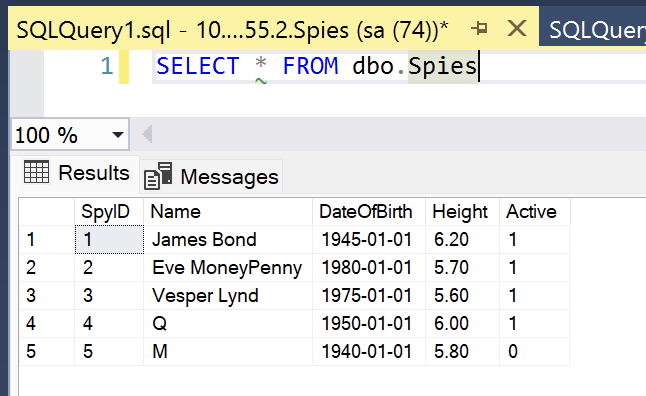
Now, let us tackle some tasks.
1. Listing Data
For this, we will create an API endpoint, and within it, we shall use the generic Query<T> method, specifying our query and passing Spy as the type parameter. We then call AsList() to return a list of Spy, which we return to the user.
app.MapGet("/List", (SqlConnection cn, ILogger<Program> logger) =>
{
var spies = cn.Query<V1.Spy>("SELECT * FROM Spies").AsList();
return Results.Ok(spies);
});
app.Run();
This will return the following:
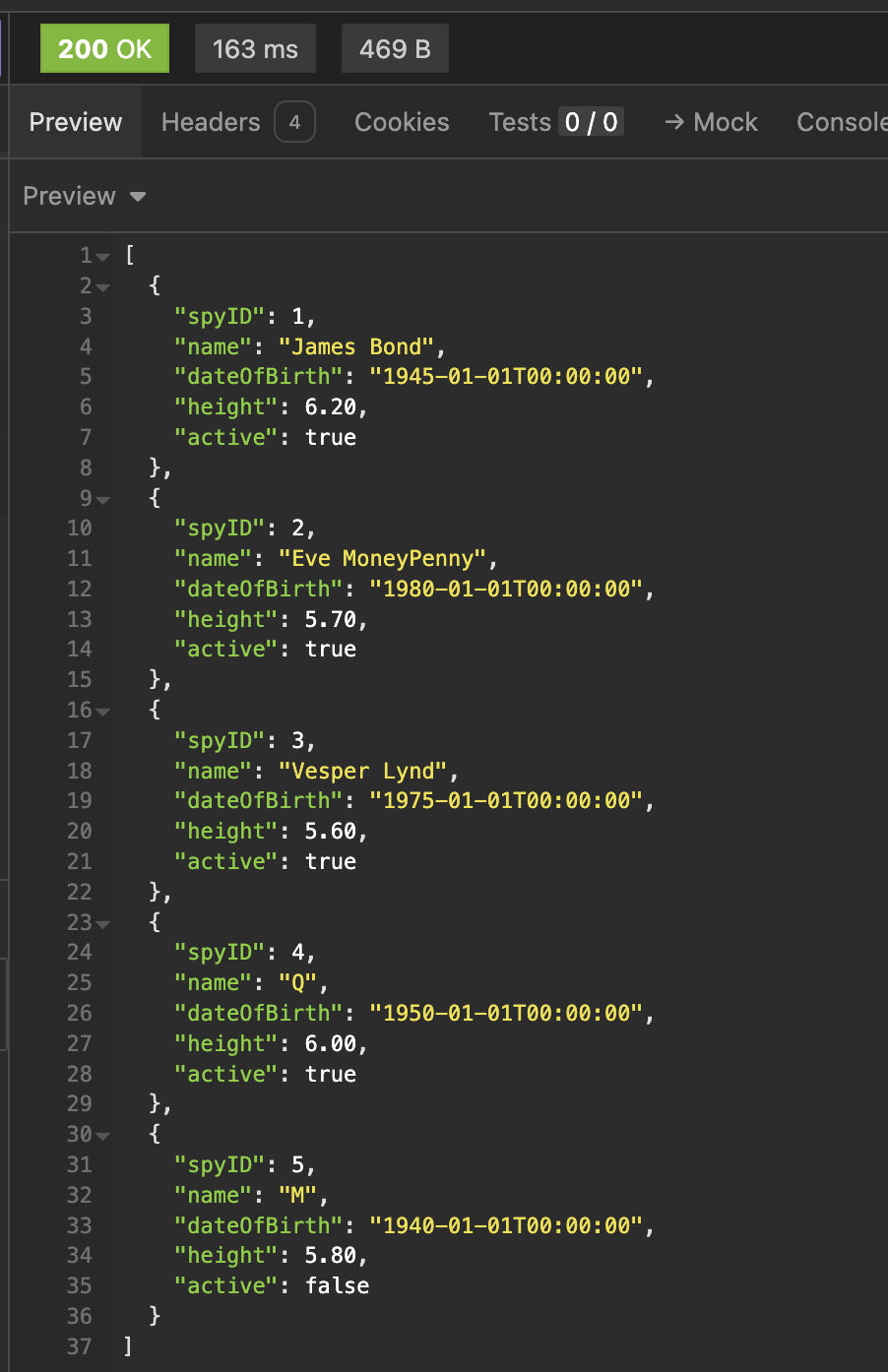
Specifying the query as follows:
SELECT * FROM Spies
is a bad habit, as columns being renamed would quietly break your code.
It is better to be explicit and specify the query as follows:
SELECT
Spies.SpyID,
Spies.Name,
Spies.DateOfBirth,
Spies.Height,
Spies.Active
FROM
dbo.Spies;
What if your type was as follows:
namespace V2
{
public sealed record Spy(int ID, string FullNames, DateTime BirthDate);
}
Here, the properties are named differently from the columns, and we are not using some of the attributes.
In such a scenario, we do the following:
-
Rewrite our query to provide aliases to the columns we want
SELECT Spies.SpyID ID, Spies.Name FullNames, Spies.DateOfBirth BirthDate FROM dbo.Spies; -
We omit the columns that we don’t need
The updated code is as follows:
app.MapGet("/List", (SqlConnection cn, ILogger<Program> logger) =>
{
const string query = """
SELECT
Spies.SpyID ID,
Spies.Name FullNames,
Spies.DateOfBirth BirthDate
FROM
dbo.Spies;
""";
var spies = cn.Query<V2.Spy>(query).AsList();
return Results.Ok(spies);
});
The results are as follows:
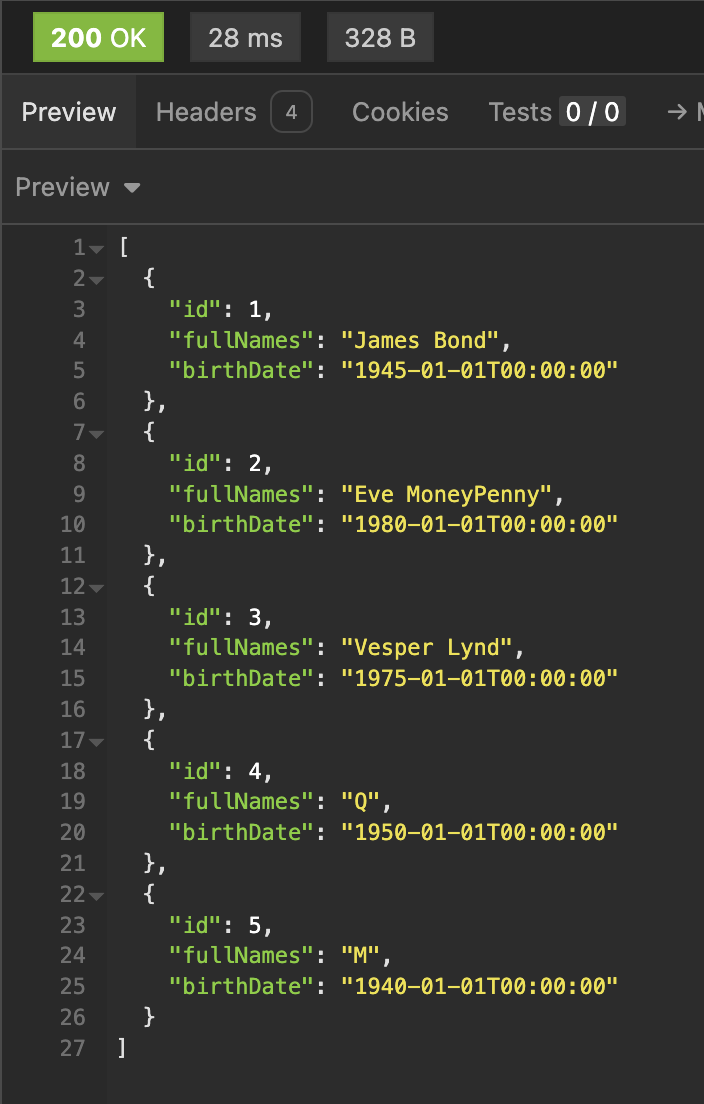
2. Filtering Returned Data
We can achieve that by querying database data using parameters.
Let us say we wanted a list of every active Spy.
We write a new endpoint, as follows:
app.MapGet("/ActiveList", (SqlConnection cn, ILogger<Program> logger) =>
{
const string query = """
SELECT
Spies.SpyID ID,
Spies.Name FullNames,
Spies.DateOfBirth BirthDate
FROM
dbo.Spies WHERE Active = @Active;
""";
var param = new DynamicParameters();
param.Add("Active", true);
var spies = cn.Query<V2.Spy>(query, param).AsList();
return Results.Ok(spies);
});
We are using DynamicParameters to pass the boolean Active filter to the query.
This returns the following:
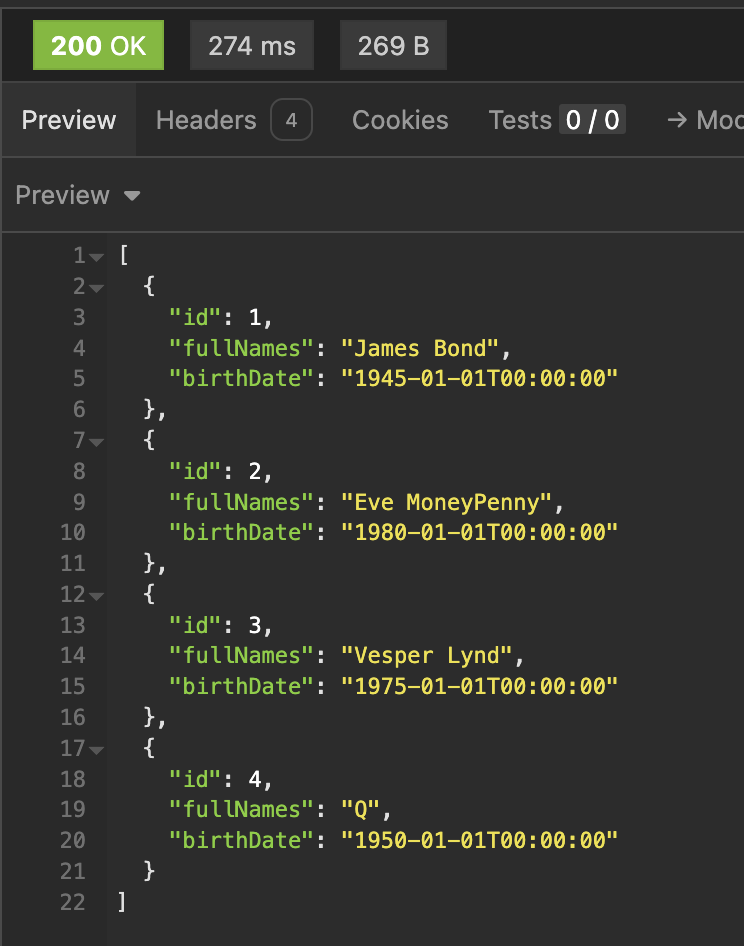
You do not have to use DynamicParameters for this purpose—you can also use anonymous types, provided the attributes of your anonymous type match the parameter names (they are not case-sensitive).
For example, we can define an endpoint where we specify a desired height in the URL route, and the API will fetch all active spies that are that height or taller for us.
app.MapGet("/ActiveByHeight/{height:decimal}", (SqlConnection cn, ILogger<Program> logger, decimal height) =>
{
const string query = """
SELECT
Spies.SpyID,
Spies.Name,
Spies.DateOfBirth,
Spies.Height,
Spies.Active
FROM
dbo.Spies WHERE Active = @Active AND Height >= @Height;
""";
var spies = cn.Query<V1.Spy>(query, new { Active = true, Height = height }).AsList();
return Results.Ok(spies);
});
If we query for all Spy entities that are 6.2 and above…

An additional benefit of Dapper is it allows you to have types that have computed fields.
We can define version 3 of our Spy as follows:
namespace V3
{
public sealed record Spy
{
public required int ID { get; init; }
public required string FullNames { get; init; }
public required DateTime BirthDate { get; init; }
// Compute the age against the current year
public int Age => DateTime.Now.Year - BirthDate.Year;
}
}
We can then write another endpoint to fetch this new type:
app.MapGet("/ActiveListComputed", (SqlConnection cn, ILogger<Program> logger) =>
{
const string query = """
SELECT
Spies.SpyID ID,
Spies.Name FullNames,
Spies.DateOfBirth BirthDate
FROM
dbo.Spies WHERE Active = @Active;
""";
var param = new DynamicParameters();
param.Add("Active", true);
var spies = cn.Query<V3.Spy>(query, param).AsList();
return Results.Ok(spies);
});
This returns the following:
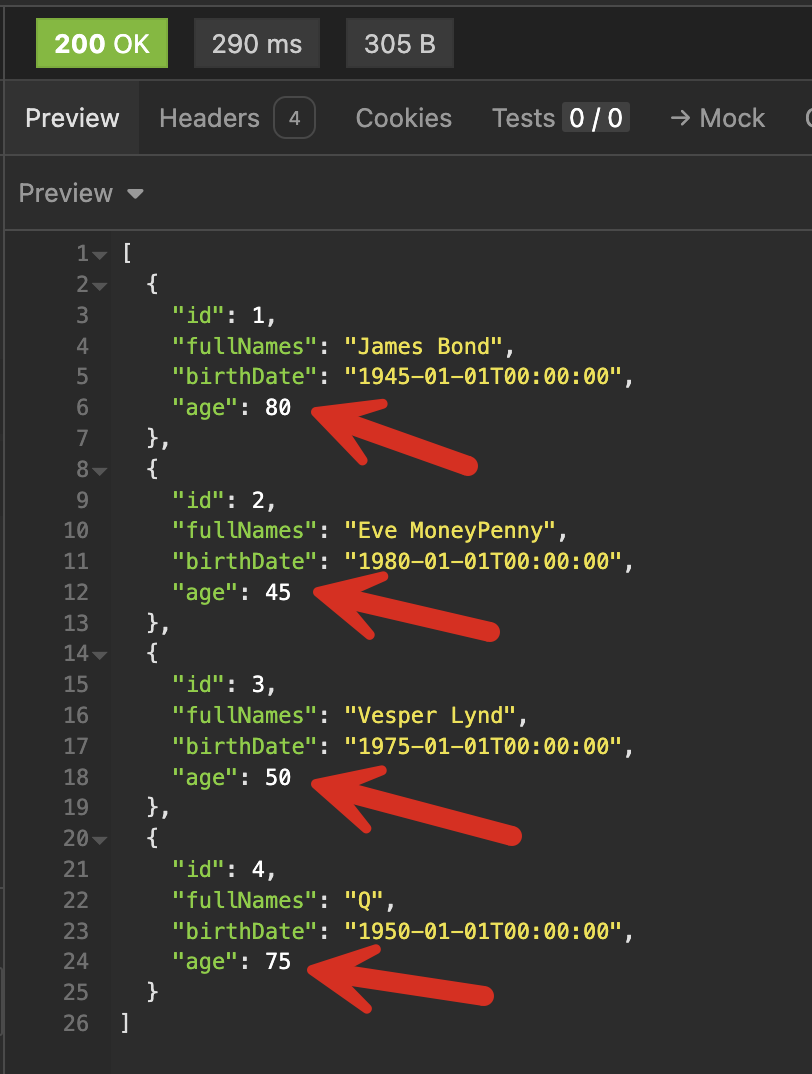
Of course, for this to work correctly, BirthDate must be specified in the query.
3. Fetching Single Rows
Dapper also allows you to fetch a single row from the database.
We can see how this works with another endpoint that fetches a Spy by their ID:

When using QuerySingle, if the database does not return a result or returns more than 1, an exception will be thrown.
You can mitigate this (and improve your endpoint) by using QuerySingleOrDefault as follows:
var spies = cn.QuerySingleOrDefault<V1.Spy>(query, new { ID = id });
if (spies != null)
return Results.Ok(spies);
return Results.NotFound();
QuerySingleOrDefault will return a null if no data meets the criterion.
4. Using Stored Procedures
In our examples, we have used inline queries.
Dapper works in exactly the same way if you use stored procedures.
Assuming we had this procedure:
CREATE OR ALTER PROC [Spies.GetByStatus] @Status BIT
AS
SELECT
Spies.SpyID,
Spies.Name,
Spies.DateOfBirth,
Spies.Height,
Spies.Active
FROM
dbo.Spies
WHERE
Spies.Active = @Status;
We can define an endpoint that we can provide a desired status and have the API fetch the data for us:
app.MapGet("/ListByStatus/{status:bool}", (SqlConnection cn, ILogger<Program> logger, bool status) =>
{
var spies = cn.Query<V1.Spy>("[Spies.GetByStatus]", new { Status = status }).AsList();
return Results.Ok(spies);
});
This will return the following:
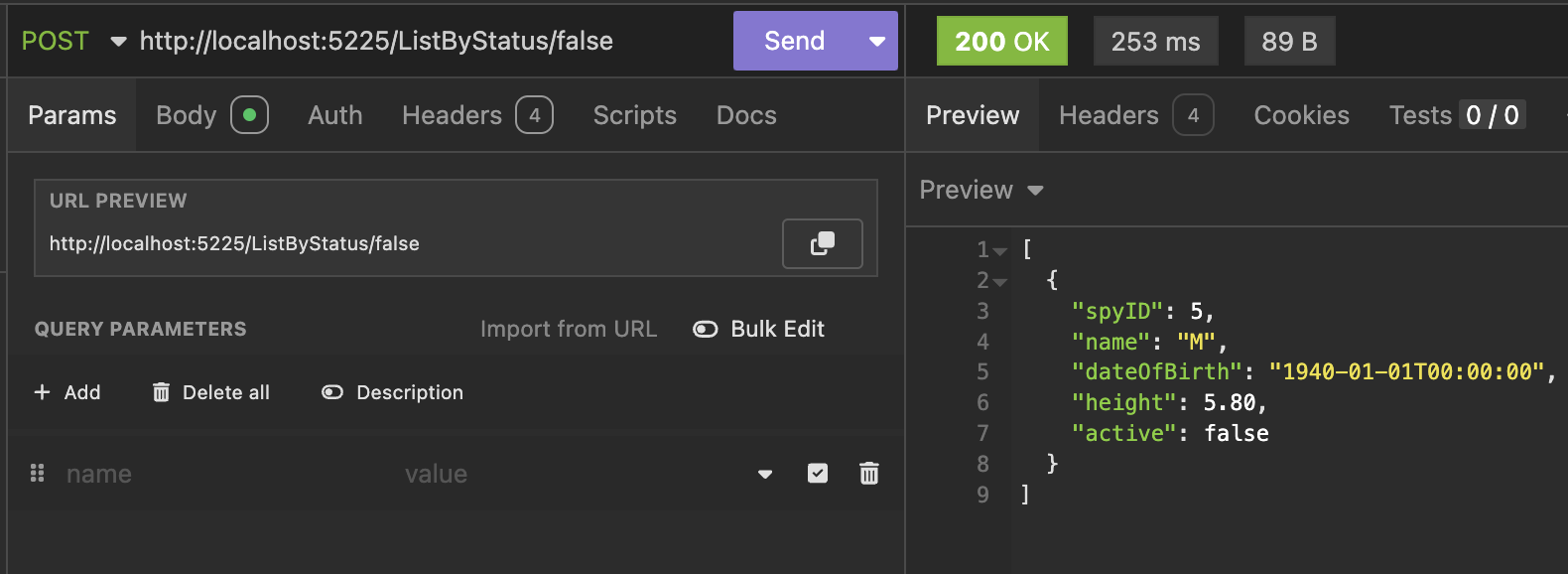
5. Querying Single Values
Dapper can also allow you to query single values as primitive types.
For example, if we needed an endpoint that counted the number of active Spy entities, we would do it as follows:
app.MapGet("/ActiveSpyCount/", (SqlConnection cn, ILogger<Program> logger) =>
{
var spyCount = cn.QuerySingle<int>("SELECT COUNT(1) FROM Spies WHERE Active=1");
return Results.Ok(spyCount);
});
Here, QuerySingle takes an int as the generic parameter.
The result is as follows:

Here, we are certain that a result will return - 0 or anything else.
However, there are scenarios where your query will not return anything. In this case, an exception will be thrown.
If you are unsure of getting a result, use QuerySingleOrDefault<T> instead. If nothing is returned, the default value of the type <T> will be returned instead - 0 for numerics, DateTime.MinValue for dates, false for booleans, and null for everything else, including your own custom types.
If there are multiple results and you only want one, use QueryFirst<T> or QueryFirstOrDefault<T>.
Bonus
- Your types do not need to have setters -
Dapperwill use reflection and correctly set the properties of types that have read-only public properties. This, however, is not the case if you are using VB.NET. Mapping will fail if your type has no setters. - If you use
Query<T>and omitAsList(), you will get back anIEnumerable<T>, which you can use for intermediate lazy processing. - All the methods mentioned in this post -
Query,QuerySingle,QuerySingleOrDefault,QueryFirst,QueryFirstOrDefaulthaveasyncequivalents that you can execute asynchronously.
In our next post, we will look at how to execute queries in the database that do not return results.
TLDR
Dapper can map complex types or primitive return types from database queries for you.
The code is in my GitHub.
Happy hacking!